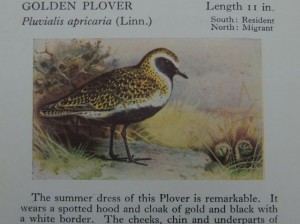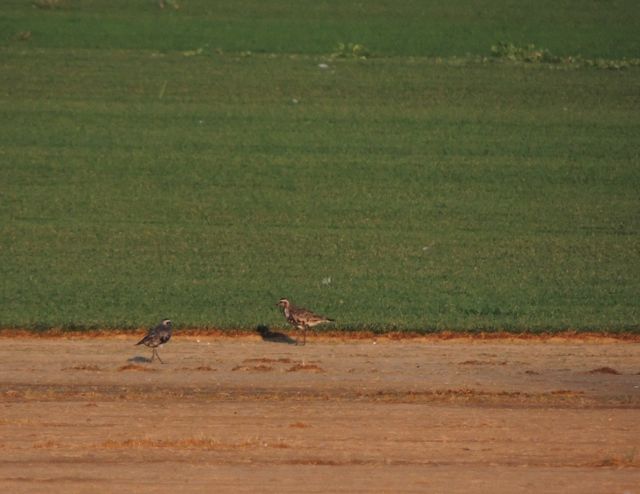27 August 2013. Caledonia ON. As a child growing up in post-war England my sole birding reference was the Observers Book of Birds. Just 200 breast-pocket sized pages with usually one species per page, a beautiful watercolour illustration by the likes of Archibald Thorburn and a brief written description, it was the bible of British birds. Even though there was a Peterson Guide to the Birds of Britain and Europe published in 1954, I wasn’t aware of it and it wasn’t until well into the sixties that anything like today’s really useful and comprehensive field guides came to my attention. By then it was too late, my mental images of British birds were fixed; perhaps it’s as well that I left home to start all over again with new birds in Canada.
 Among those fixed images is the Golden Plover, it figures a rather pensive looking bird gazing at a couple of uncurling fern fronds. The ensuing description includes this captivating element, “The summer dress of this plover is remarkable. It wears a spotted hood and cloak of gold and black with a white border.”
Among those fixed images is the Golden Plover, it figures a rather pensive looking bird gazing at a couple of uncurling fern fronds. The ensuing description includes this captivating element, “The summer dress of this plover is remarkable. It wears a spotted hood and cloak of gold and black with a white border.”
Today I made a deliberate excursion to look for American Golden Plovers, which are to all intents and purposes identical to the basic European species referred to above. I stopped along a rural roadside to see if any were feeding on the wide expanses of a sod farm. They seek out wide-open spaces on their migration, golf courses and sod farms included, which, while it may seem a little odd, is I suppose a good example of adaptation.
Anyway here on one of the world’s largest lawns there was a lot of activity; a practiced crew of sun-crisped men were harvesting long peels of turf grass and piling it in tidy stacks. Watching them carefully were lines of Ring-billed Gulls, and scatterings of Killdeers and American Golden Plovers all hoping to snatch a squirming meal from the freshly exposed earth. The gulls were generally indifferent to the men’s noisy activities and stayed close to them at all times, the Killdeers were a little more inclined to fly off as machinery approached and the Golden Plovers were so baffled by it all that they moved quite a long way away until the workers took a coffee break, then they came closer where I enjoyed lingering views of them.
Golden plovers are moulting at this time of year, their gold spangling and expansive black underparts give way to an overall beige and brown flecking and non-descriptness, so today’s birds were part way through that process and not quite the pot of gold I might have wished for, still they’re beautiful (as are their cousins the Black-bellied Plovers-see previous entry). They struck me as quite large birds, yet, according to all references, they’re just about the same as a Killdeer in overall length; but here posture and carriage make a big difference, the American Golden Plover’s more upright, on-the-lookout-for-trouble demeanour gives an impression of greater size.
I managed to get a few for-the-record photos, the distance was too great for much detail to be evident, still here’s one, although I think the watercolour illustration at the top is better.